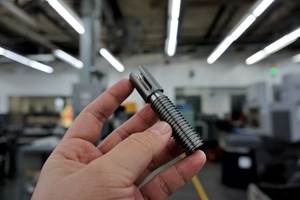Benefits And Costs Of Process Simulation
For companies that have implemented digital manufacturing, the return on investment is there . . . but the scope of that investment goes well beyond the price of software.
For companies that have implemented digital manufacturing, the return on investment is there . . . but the scope of that investment goes well beyond the price of software. That was the conclusion of a study by D.H. Brown Associates, an information technology consulting firm that analyzed digital manufacturing by interviewing managers involved in justifying the technology for large manufacturers in the aerospace, automotive, and heavy equipment industries.
“Digital manufacturing” means simulating the manufacturing process using 3D CAD models. The goal is to streamline manufacturing process development time, largely by catching bugs and inefficiencies in the simulation instead of in real life. The technology applies to more than machining. Manufacturers facing high capital equipment costs also use it to optimize assembly, welding and other processes before tooling, machine motions, and machine placement are finalized.
The potential payback includes reduced ramp-up time for new processes, as well as the problems—like collisions—that are avoided early. However, in many companies, achieving these results can require nothing short of a culture change. For digital manufacturing to be effective, those who develop new processes must be willing to trust what they see on screen. Thus, process designers are asked to make a leap similar to the one that product designers were asked to make about a decade ago, back when 3D CAD modeling was new.
This table from D. H. Brown Associates lists typical considerations for companies attempting to justify digital manufacturing.Costs
• Digital manufacturing software
• Computer hardware
• New business process development
• Culture change implementation
• Software training
• New business process training
• Extra labor required to achieve proficiency in new software and a new business process
Benefits
• Quicker time to market
• Reduced per-unit production cost
• Reduced overall labor cost
• Higher quality manufacturing process
• Reduced manufacturing process development cost
• Reduced rework and faster part learn-out
• Higher reuse of existing manufacturing equipment
Another potentially large investment is the effort required to input the data necessary for the system to develop its models. In fact, software company Deneb Robotics (Troy, Michigan) is fundamentally changing its manufacturing simulation products, and one of its key reasons for doing so is to reduce the scope of this data feeding task. In the past, this company’s systems for simulating machining, assembly, welding and other operations were limited in their ability to share data seamlessly with one another. However, versions of these products now being released can freely draw from a common database. These systems also share a modeling kernel in common—the kernel used in CATIA. (The company is a subsidiary of CATIA developer Dassault Systems.)
Deneb’s module for simulating machining processes is called Virtual NC. The system relies on available CAD data to develop 3D models of the machine tool, tooling, and workpiece, and uses these models to simulate NC tool paths and look for collisions. An example of where this software makes sense comes from a Lockheed Martin Energy Systems plant in Oak Ridge, Tennessee. By using the simulation software to test 500 new programs for an eight-axis milling machine, Lockheed Martin programmers cut their total program prove-out time in half. Also, programmers were able to test and debug probing subroutines, as well as a postprocessor, before the machine had even been built.
The software also let programmers make precise corrections to the process. In one case where the software detected a collision, the programmer responded by extending the tool about two inches—the minimum change necessary for the collision to be avoided. Because this change was so small, the machine operator was called in to watch the simulation. He had to be prepared for how narrowly the machine would avoid hitting the work.—PCZ
Related Content
When Handing Down the Family Machine Shop is as Complex as a Swiss-Turned Part
The transition into Swiss-type machining at Deking Screw Products required more than just a shift in production operations. It required a new mindset and a new way of running the family-owned business. Hardest of all, it required that one generation let go, and allow a new one to step in.
Read MoreHow to Mitigate Chatter to Boost Machining Rates
There are usually better solutions to chatter than just reducing the feed rate. Through vibration analysis, the chatter problem can be solved, enabling much higher metal removal rates, better quality and longer tool life.
Read MoreContinuous Improvement and New Functionality Are the Name of the Game
Mastercam 2025 incorporates big advancements and small — all based on customer feedback and the company’s commitment to keeping its signature product best in class.
Read MoreHow this Job Shop Grew Capacity Without Expanding Footprint
This shop relies on digital solutions to grow their manufacturing business. With this approach, W.A. Pfeiffer has achieved seamless end-to-end connectivity, shorter lead times and increased throughput.
Read MoreRead Next
Rego-Fix’s Center for Machining Excellence Promotes Collaboration
The new space includes a showroom, office spaces and an auditorium that will enhance its work with its technical partners.
Read MoreThe Future of High Feed Milling in Modern Manufacturing
Achieve higher metal removal rates and enhanced predictability with ISCAR’s advanced high-feed milling tools — optimized for today’s competitive global market.
Read More5 Rules of Thumb for Buying CNC Machine Tools
Use these tips to carefully plan your machine tool purchases and to avoid regretting your decision later.
Read More








.jpg;maxWidth=300;quality=90)
















